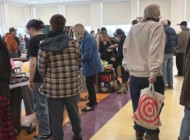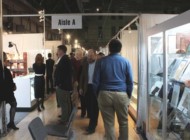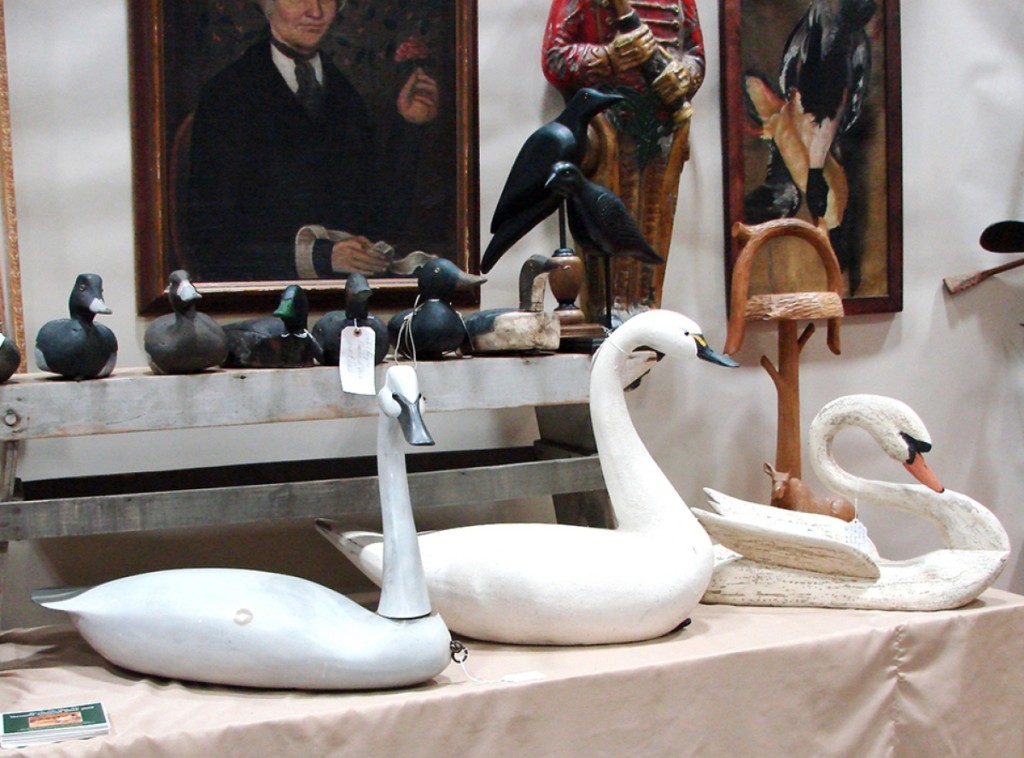
John Bourne, Pittsford, Vt., had, among other carvings, three swan decoys. The one on the left was priced $775 and the one on the right, with a crusty surface, was priced $575.
Review and Onsite Photos by W.A. Demers
CONCORD, N.H. – The Concord, N.H., show, known as the Americana Celebration Antiques Show, is a one-day show on Tuesday August 6 during Antiques Week in New Hampshire. It has evolved over the four years that Peter Mavris has been running it. The show has 50 dealers in generous room-setting booths, the venue is air-conditioned – although it wasn’t needed much this year – the aisles are carpeted and the crowd was ready to spend money. The early buyers, who paid $25 for admission at 8 am on August 6, numbered about 345, and the regular admission buyers, starting at 10 am, numbered about another 450. This is a quality Americana and folk art show that attracts many dealers who set up at shows later in the week and numerous collectors. One dealer, who until recently had exhibited at the New Hampshire Antique Dealers show, and now does the Mavris show, said, “It’s much easier. This show is one day and the other is three days. Add in the setup day and this is a whole lot less work. Just right for us.”
The variety is wide: folk art, both traditional and Outsider, early painted and formal furniture, samplers and other textiles, cloth dolls, trade signs, stoneware, paintings, books, hooked rugs, early glass and ceramics. The ceramics included delft, Staffordshire and more. Folk art included weathervanes, including one with so many bullet holes that it was barely a weathervane anymore, and decoys. Dealers were writing sales slips shortly after the opening and red dots appeared in several booths. Among the early sales were weathervanes, small pieces of furniture, silver and, not surprisingly, painted woodenware, of which there was much to choose from.
J.S. Cocoman, Glenmont, N.Y., had one of the nicest quilts on the floor. It had brightly colored stars in each corner along with a central motif of stars. The border was of polished chintz, and he priced the quilt at $1,750. Several dealers brought interesting furniture. Mike and Lucinda Seward had a red grain-painted blanket chest with two false drawers over two drawers.
One of the nicest painted pieces was a circa 1790-1810 blanket chest on a bracket base with two small drawers, original brass and great surface in old blue paint. Griffith’s Antiques, Utica, N.Y., said this was the first time they had showed the piece and priced it at $1,495. If you would have preferred your blanket chest in old red, there were several from which to choose. Patriot Antique Shop, Tipp City, Ohio, had a four-drawer chest on a cutout bracket base. Downer’s Grove, Ill., dealer Mary DeBuhr had what looked like a pair of early settles in old brown paint, each about 4 feet long. But appearances can be deceiving. She said that she had bought an 8-foot-long settle and knew that not many homes could accommodate one that large. So-she had it cut in half and two new ends made by a skilled worker. The two new ends perfectly matched the color of the rest of the piece. She said they could be bought as a pair or separately.
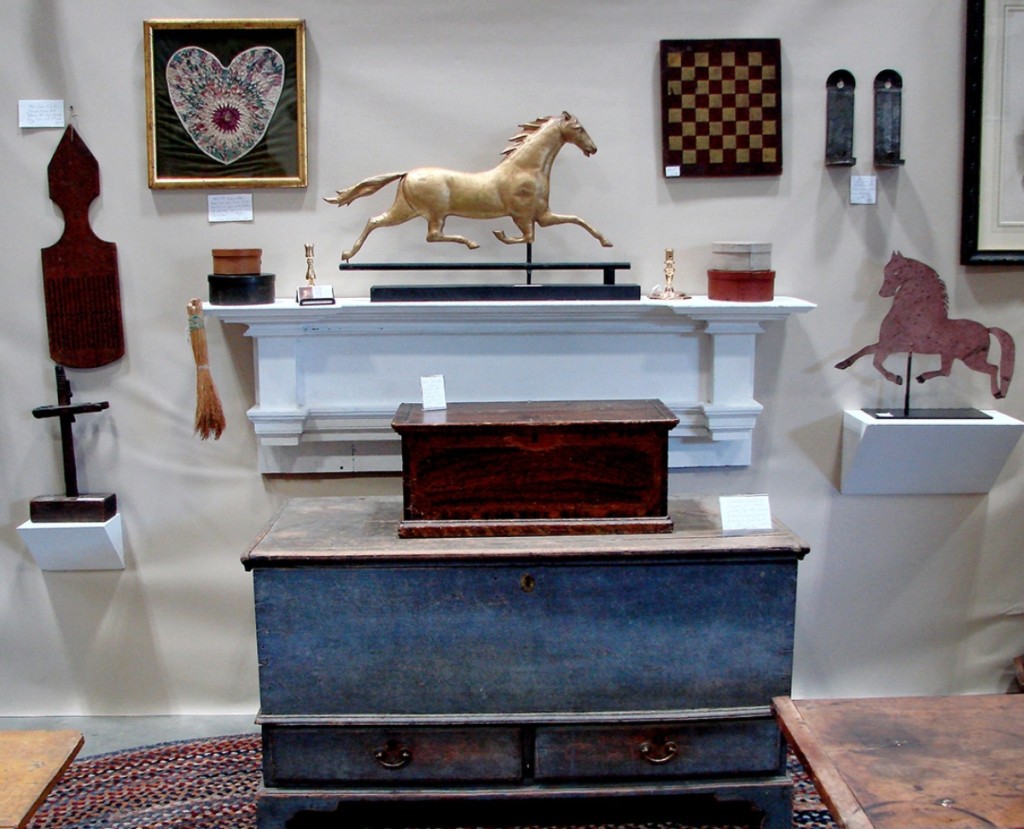
Utica, N.Y., dealers Griffith’s Antiques priced this 1790-1810 blanket chest in old blue paint at $1,495. The running horse weathervane with a zinc head, “Smuggler,” was probably made by Harris. It was priced $2,200.
There was plenty of other furniture on the floor. Morgan MacWhinnie, Southampton, N.Y., had a large booth full of furniture, as he always does. There was not a lot of Victorian furniture, but Bob Markowitz, Groveland, Mass., brought two pieces of late Victorian turned mahogany furniture made by the Merklin Brothers. They had emigrated from Alsace-Lorraine, worked in New York between 1885 and 1897 and advertised themselves as “Makers of Fine Spiral Furniture.” Markowitz’s armchair had cast brass bird heads on the uprights. The armchair was priced at $695 and the table was $295.
There was not a lot of Outsider art at the show, but Mike and Lucinda Seward, Pittsford, Vt., had a painting of an alligator by Jimmie Lee Sudduth (1910-2007). He was born in Alabama and began painting at early age, making his own paints from rocks, plants, foodstuffs and other found materials. He painted with his fingers “because they never wore out.” He was featured on The Today Show and 60 Minutes in 1980, and his works are in the collections of the Smithsonian and several other museums.
Numerous trade signs were available. An unusual one of automotive interest was in Bob Markowitz’s booth. It was a large, carved and well-weathered wooden sign that he believed had been used to advertise the Morse Motor Company. The sign depicted the front end of an early automobile with the letters “MM.” The steering wheel of the car was on the right side, which Markowitz said indicated that it pre-dated 1909, by which date nearly all manufactures in the United States had moved the steering wheel to the left side of the car, where it remains today. The sign was priced at $1,800 and sold shortly after the show opened.
Some of the unusual items at the show included a large bird cage. A person who has enough space to collect Victorian birdcages might have been tempted by this one in the booth of Karen Wheaton, Maria’s Pond Antiques, Pattersonville, N.Y. It had three large wire towers with separate pullout trays, so it could have accommodated numerous small birds. Wheaton’s label suggested that those not interested in using it as it was intended might use it for plants. She said that she had owned it for about 30 years and she priced it at $1,550.
Another unusual item was an alligator foot that had been professionally mounted and could be used as a vase. Matt Greig, Milton, Del., had it, along with an eclectic selection of many other things. It’s always a booth to spend some time in. A group of three large outdoor bronze sculptures that may have been used in a church graveyard were in the booth of Tom Joseph, Limington, Maine. Each was more than 4 feet tall, with a well-weathered surface. Two were signed, but Joseph had not been able to read the signature. They were priced individually at about $6,000 each.
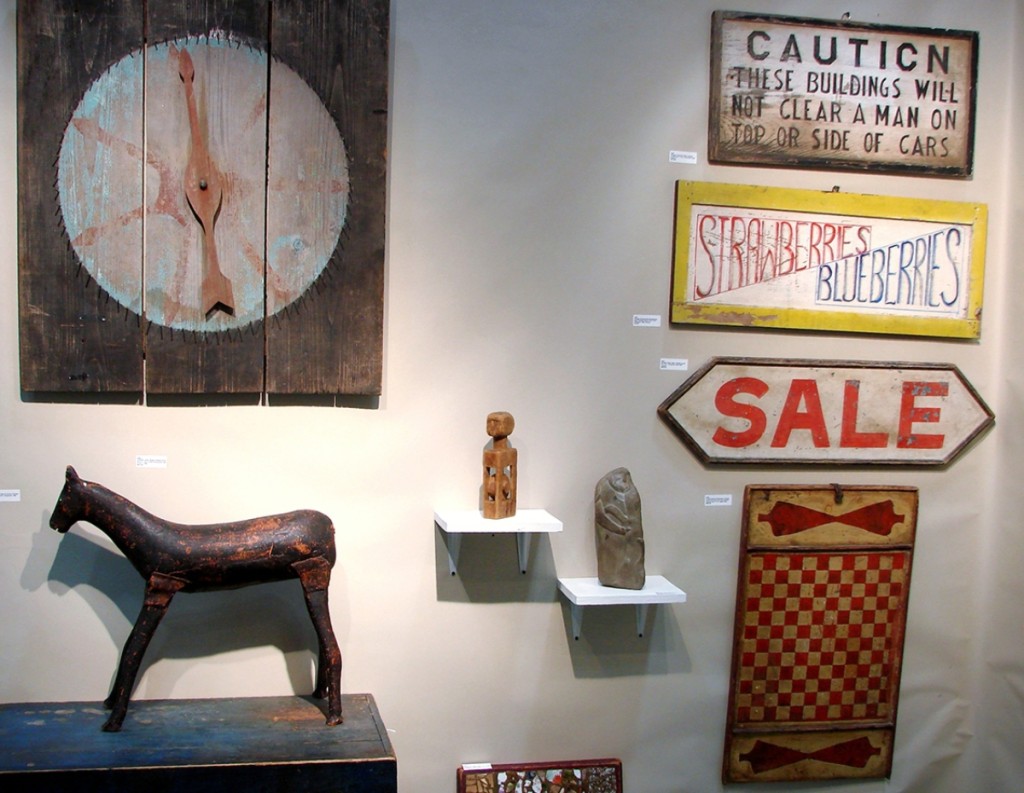
The folky carved horse was in the booth of South Road Antiques, Stanfordville, N.Y., and the large game wheel was more than 30 inches in diameter.
Pat Hatch and Kyle Hendrick, Harvard, Mass., had a booth filled with more than 20 cloth dolls, cloth animals and other textiles, including a large 34-star American flag. Their signage indicated that it represented one of only two changes to the flag that occurred during the Civil War. The entry of Kansas as a free state in January 1861 as the 34th state required a new flag. The other change occurred 28 months later when West Virginia broke away from Virginia, creating the 35th state. The flag was priced at $1,800.
A few days after the show, Peter Mavris said that attendance was about the same as previous years. “We had 345 early buyers and another 450 throughout the day. We were around 800 last year so that’s steady. I saw a lot of stuff being carried out. I think we have the reputation of being a ‘buyable’ show for our customers and affordable for our dealers. The facility is easy for the dealers to work with and we have space in the building to add a few more dealers next year.”
For additional information, www.petermavrisantiqueshows.com or 207-608-3086.

























